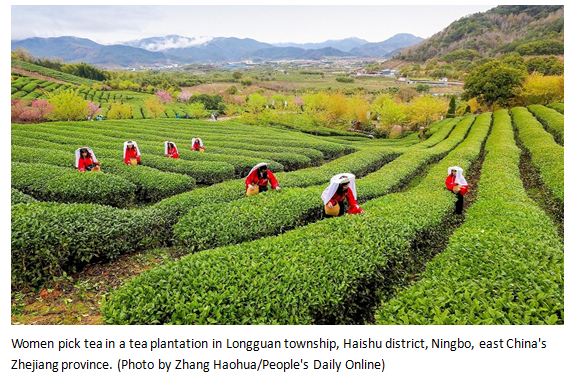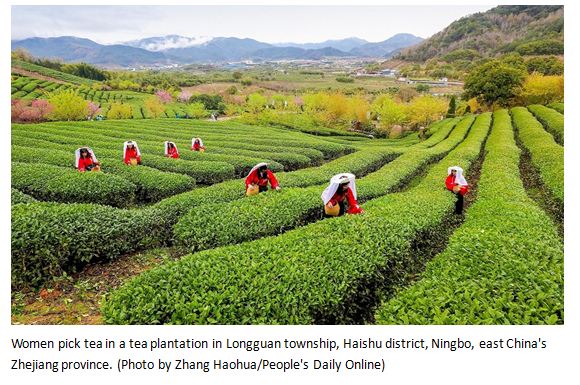By Feng Xuan, Sun Yong, Li Xiaohang, People’s Daily
On the “Zhejiang Day” sub-event held at the China Pavilion of the second part of the 15th meeting of the Conference of the Parties to the UN Convention on Biological Diversity (COP15-2) in Montreal on Dec. 9, small cans of black tea attracted attention from the representatives attending the conference.
These tea cans were gifts brought by Chinese representatives. On the red cans, it was printed “Official Collection of COP15” in Chinese, as well as “Haishu Longguan” that indicated the tea’s place of origin – Longguan township of Haishu district, Ningbo, east China’s Zhejiang province.
The COP15-2 came just days after China’s traditional tea-making techniques and associated social practices were officially added to the Representative List of Intangible Cultural Heritage for Humanity by the UN Educational, Scientific, and Cultural Organization (UNESCO).
The tea in the red cans, picked in April this year, was a local specialty of Longguan township. It is a top prize winner at the Zhejiang Agricultural Fair.
Yu Ting, the party head of Longguan township, said the philosophy of carbon reduction was embedded in all production procedures of the tea, from planting to picking and from processing to transportation. He called the tea “an outcome of the biodiversity protection of Longguan township.”
The tea was grown in a 66.7-hectare plantation on Siming Mountain in Longguan township. The plantation, which also grows green tea and white tea, is activeand busy all year.
Yang Jinliang, owner of the plantation, told People’s Daily that the plantation is a beneficiary of the sound ecology and also contributes to further improving the ecology.
Under the guidance of local authorities, Yang and other tea farmers have been striving to reach the carbon reduction goals in all industrial chains of tea production. Today, carbon emissions by the plantation in tea planting, processing, transportation, consumption, and waste gas treatment are monitored online.
Yang has also joined the making of Chinese carbon labelling standards for tea products. “In the future, the labelling will not only improve products’ added value but also enhance people’s awareness of purchasing low-carbon agricultural and sideline products,” he said.
The Guideline for Biodiversity-friendly Township Planning was published at COP15-2, in both Chinese and English. The guideline was compiled by the government of Haishu district and mirrored the experience in biodiversity protection gained by the district over the years.
The guideline proposed to include biodiversity conservation in township planning in a systematic, eco-friendly, economic, and inclusive manner and provided eight steps to implement biodiversity protection, such as establishing planning teams, evaluating resources, developing partnerships, and collecting ecological information. It covered four aspects of planning, including developing eco-based industries, advocating close-to-nature lifestyles, restoring authentic ecology, and carrying out inclusive treatment.
The guideline drew experience of Longguan in building a biodiversity-friendly township. At the end of 2021, Haishu district launched China’s first pilot project of the construction of biodiversity-friendly township, which attempted to integrate biodiversity conservation into rural governance, production, and people’s daily lives.
Guided by the vision of biodiversity protection, Longguan replanned the construction of a local mountain road to maximally reduce the transport project’s damage to local forests.
It moved over 100 rare plants to the botanical garden of Ningbo and ensured minimum intrusion into the living space of plants and animals when building plank roads and observation decks.
The township also set up some 20 small protection bases for ferns, Isoetes sinensis Palmers, and other plants, and built over 300 artificial bird nests and “insect hotels.”
Longguan township, covering an area of 73 square kilometers, now boasts a forest coverage of 85 percent and 25 plant and animal species under first-and second-class national protection.
From the perspective of global development, townships are an important part of biodiversity construction, said Yu Wei, one of the makers of the guideline and the executive director of the research center for carbon neutrality and green development at China Jiliang University.
He said the biggest highlight of the guideline is that it offers a standard that guides townships to incorporate biodiversity into their planning, which is a key issue in the construction of biodiversity-friendly townships.
“It sheds light on the sustainable development of townships around the world,” he added.


















